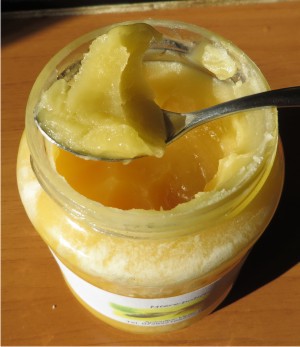Is crystallized honey spoiled?
Definitely not. If your honey turned from a liquid (runny) state into a semi-solid state, it’s exactly how they say: Don’t worry, be happy! You have got yourself a perfect natural honey! (You would most probably never find crystallized honey on a supermarket shelf, because of its previous pasteurization, filtration and other treatments, so that it would look good and last more. But the filtering process extracts a high amount of pollen and changes the quality of honey.)
Crystallization affects only the color and the texture, not the quality of it. And certainly it is not spoiled. In fact, there are people who prefer it like that, as it is more easy to spread on bread or toast, without dripping off. And the taste is even richer.
Why does it crystallize?
Crystallization takes place because honey is an over-saturated sugar solution.
The two principal sugars contained in honey are fructose and glucose and their content varies from one type of honey to another.
The balance between those two sugars leads to crystallization. Actually, glucose is more responsible of this, due to its lower solubility. Fructose is more soluble in water and it remains fluid.
So, glucose turns into tiny crystals which separate from the water. This solution will change to a saturated form, and ultimately the honey becomes thick, crystallized.
Some types of honey crystallize uniformly, but others only partially, and even form two layers, with the crystallized layer at the bottom of the jar and the liquid on top. I admit, not a very nice image.
Depending on the flower’s nectar, honey crystallizes in different periods of time. E.g.:
• multifloral honey crystallizes in 1-2 months;
• linden honey crystallizes in 3-4 months;
• acacia honey crystallizes in 18 months;
• honeydew honeys rarely crystallize. Other Australian honeys like Yellow Box, some Ironbarks or String Bark crystallize in 2-3 years.
The storage temperature is very important, too. The crystallization is more rapid around 50-59ºF (10-15ºC). Under this temperature the crystallization slows down, because the viscosity is increased and this retards the formation of crystals. Honey best resist crystallization at temperatures higher than 77ºF (25ºC). But above 104ºF (40ºC) the properties of the honey will be damaged.*
How to turn crystallized honey into liquid again?
Of course it is best to use it like that, it won’t make a messy in the kitchen, and won’t run off the bread. But if you like the runny form, all you have to do is gently heating it in a hot water bath (Bain Marie) or warming box, until the honey re-liquefies. Heating should not be applied directly, not on a direct flame. It should be heated at 95-104ºF (35-40ºC) – no more. If you overheat it, for any period of time, it will reduce the quality of it by destroying its enzymes – the most important factor, and then it losses the delicate flavor, aroma and darkens the color.

* Not all specialists agree with these temperatures. Some say that the best temperature to keep the honey is 70-80ºF (21-27ºC). Below 52-64ºF (11-18ºC) honey will rapidly crystallize. And, refrigeration should also be avoided.
****
****
References:
http://www.montcobeekeepers.org/
Ioana Tudor, Mierea Alimentul Complet, Gramen 2013.
